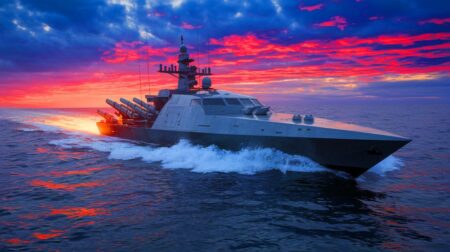| IN A NUTSHELL |
|
In the ever-evolving landscape of military aviation, the United States is poised to break new ground with the SR-72 hypersonic jet. Known as the ‘Son of Blackbird,’ this cutting-edge aircraft promises to redefine speed and strategic capability in unprecedented ways. Developed by Lockheed Martin’s secretive Skunk Works team, the SR-72 aims to surpass its legendary predecessor, the SR-71 Blackbird, by achieving speeds over Mach 5. As the world awaits its debut, anticipated by the end of 2025, the SR-72 represents a significant leap forward in hypersonic technology and military strategy.
The Secretive Development of the SR-72
The SR-72, shrouded in secrecy, is being developed by Lockheed Martin’s renowned Skunk Works division. This team is known for its trailblazing innovations in aerospace technology. According to recent reports, the SR-72 prototype is expected to be finalized by the end of 2025, positioning it as the fastest operational airframe ever built. With a top speed exceeding Mach 5, or approximately 4,000 mph, the SR-72 is designed to perform strategic intelligence, surveillance, and reconnaissance (ISR) missions in environments where traditional aircraft face significant risks.
The aircraft’s hypersonic speed will enable it to penetrate advanced integrated air defense systems, delivering critical intelligence with minimal risk of interdiction. Moreover, the SR-72 could serve as a launch platform for hypersonic strike weapons, potentially integrating the High-Speed Strike Weapon (HSSW) under development. Drawing upon the legacy of the SR-71, the SR-72 is set to enhance speed and survivability while introducing a new era of unmanned, reusable aircraft capable of autonomous missions at hypersonic velocities.
Revolutionizing Propulsion with TBCC Technology
The SR-72’s revolutionary propulsion system lies at the heart of its hypersonic capabilities. Unlike conventional aircraft, the SR-72 employs a turbine-based combined cycle (TBCC) propulsion system. This innovative system merges a traditional turbofan engine with a supersonic combustion ramjet, or scramjet, to sustain speeds above Mach 5. The dual-mode propulsion is essential, as no single engine can efficiently operate across the full subsonic-to-hypersonic flight envelope.
At over 100 feet in length, the SR-72 mirrors the dimensions of the SR-71 but introduces a fundamentally different propulsion architecture. The TBCC configuration is not merely a performance enhancement; it is an operational necessity for the SR-72 to achieve its ambitious speed goals. By combining different propulsion technologies, the SR-72 can efficiently transition from subsonic to hypersonic speeds, paving the way for new military and strategic applications.
Strategic Mobility and Global Reach
The SR-72’s hypersonic speed redefines strategic mobility, offering unparalleled global reach. With the ability to fly at speeds over Mach 5, the SR-72 can travel from the continental United States to Europe or Asia in approximately 90 minutes. This fast global reach provides commanders with quick intelligence and strike capabilities, enabling faster decision-making in rapidly evolving operations.
However, the SR-72 program faces significant technical and financial challenges. While preliminary discussions with US government stakeholders have occurred, full funding for a demonstrator airframe and engine development has yet to be secured. The program’s alignment with the USAF’s hypersonic roadmap indicates a notional in-service date by 2030, contingent on overcoming propulsion, thermal management, and materials challenges inherent to sustained hypersonic flight.
Overcoming Modern Air Defense Systems
In an era where modern air defense systems like the S-500 and HQ-19 necessitate platforms capable of operating at speeds and altitudes beyond interception range, the SR-72’s high-speed profile is designed to counter these threats. By reducing time-on-target and exposure windows, the SR-72 enhances survivability and effectiveness in contested environments.
Conventional turbojets and turbofans are inadequate for such missions, making the TBCC configuration an operational necessity. If successfully fielded, the SR-72 will mark a transformative milestone in aerial reconnaissance and strike capability. The aircraft could redefine how the United States projects power in denied-access environments by leveraging next-generation propulsion technologies and uncrewed systems architecture.
The SR-72 hypersonic jet stands at the forefront of military aviation, promising to revolutionize speed and strategic capability. As the United States continues to advance its hypersonic technology, the SR-72 could become a pivotal asset in maintaining global military superiority. However, with significant technical and financial hurdles still to overcome, the journey to operational status remains challenging. What implications will the SR-72’s deployment have on global military dynamics and future technological advancements?
Did you like it? 4.4/5 (26)








Wow, Mach 5! That’s faster than my morning commute! 😅
C’est incroyable! Mais est-ce que ce projet sera vraiment en place d’ici 2025?
How do they plan to handle the heat generated at such high speeds?
The SR-72 sounds impressive, but will it be affordable for the military budget?
Can’t wait to see this “Son of Blackbird” in action! 🚀
Will there be any environmental impacts from flying at hypersonic speeds?
Je suis un peu sceptique sur ces délais. 2025, c’est demain!
Is the SR-72 going to be manned or unmanned?
Ça va être un monstre dans les airs! J’espère qu’il ne va pas trop effrayer les autres avions. 😜
With such speed, can it really gather detailed intelligence?